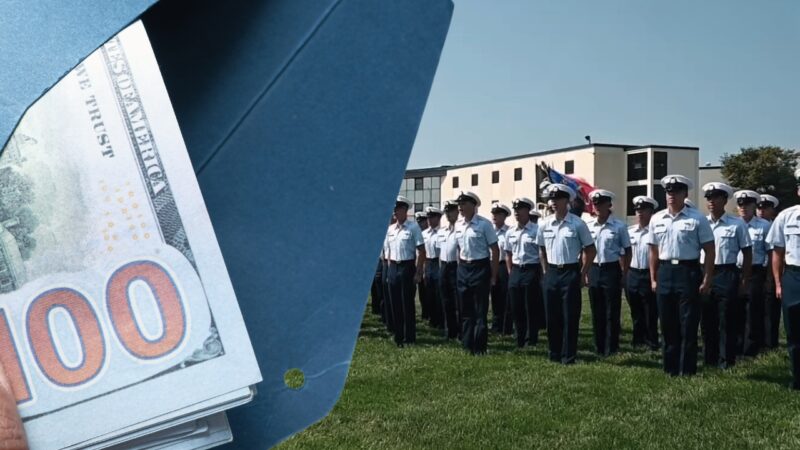Coast Guard salary is primarily determined by rank and experience.
For enlisted personnel, pay rates are based on pay grade, which ranges from E-1 to E-9, with incremental increases corresponding to years of service.
Similarly, officers in the Coast Guard follow a structured pay scale, where higher ranks and additional years of experience result in higher pay.
For example, a Commander may start with a base pay of $6,725.70 per month, which increases with years of service.
Those who achieve the highest ranks, such as Admiral, can earn significantly more, reflecting their extensive responsibilities and leadership roles.
In addition to base pay, Coast Guard personnel may receive various allowances and bonuses depending on their duties and location.
Table of Contents
ToggleWhat are the U.S Coast Guard Ranks and What are their Salaries?
Now, let us take a look at Coast Guard ranks and how they affect the salary.
| Pay Grade | Rank | Classification | 2024 Pay Range |
|---|---|---|---|
| E-1 | Seaman Recruit | Seaman | $2,017 per month |
| E-2 | Seaman Apprentice | Seaman | $27,133 – $27,385 per year |
| E-3 | Seaman | Seaman | $28,530 – $32,162 per year |
| E-4 | Petty Officer Third Class | Petty Officer | $31,604 – $38,369 per year |
| E-5 | Petty Officer Second Class | Petty Officer | $34,466 – $48,917 per year |
| E-6 | Petty Officer First Class | Petty Officer | $37,627 – $58,277 per year |
| E-7 | Chief Petty Officer | Chief Petty Officer | $43,499 – $78,188 per year |
| E-8 | Senior Chief Petty Officer | Chief Petty Officer | $62,579 – $89,248 per year |
| E-9 | Master Chief Petty Officer | Chief Petty Officer | $76,446 – $118,696 per year |
| E-9 | Command Master Chief Petty Officer | Chief Petty Officer | $76,446 – $118,696 per year |
| E-9 | Master Chief Petty Officer Of The Coast Guard | Chief Petty Officer (Special) | $76,446 – $118,696 per year |
| W-2 | Chief Warrant Officer 2 | Chief Warrant Officer | $51,131 – $85,342 per year |
| W-3 | Chief Warrant Officer 3 | Chief Warrant Officer | $57,787 – $101,365 per year |
| W-4 | Chief Warrant Officer 4 | Chief Warrant Officer | $63,277 – $117,860 per year |
| O-1 | Ensign | Junior Officer | $45,914 – $57,776 per year |
| O-2 | Lieutenant Junior Grade | Junior Officer | $52,902 – $73,210 per year |
| O-3 | Lieutenant | Junior Officer | $61,225 – $99,612 per year |
| O-4 | Lieutenant Commander | Junior Officer | $69,638 – $116,269 per year |
| O-5 | Commander | Senior Officer | $80,708 – $137,120 per year |
| O-6 | Captain | Senior Officer | $96,815 – $171,389 per year |
| O-7 | Rear Admiral Lower Half | Flag Officer | $127,667 – $190,750 per year |
| O-8 | Rear Admiral | Flag Officer | $153,644 – $221,497 per year |
| O-9 | Vice Admiral | Flag Officer | $217,152 – $221,900 per year |
| O-10 | Admiral | Flag Officer | $18,492 per month |
Rank Structure and Insignia
The Coast Guard has a detailed rank hierarchy that organizes personnel based on their roles and responsibilities. The rank structure includes enlisted ranks, warrant officer ranks, and officer ranks.
- Enlisted Ranks: Start from Seaman Recruit (E-1) to Master Chief Petty Officer (E-9).
- Warrant Officers: Cover W-2 to W-5.
- Officer Ranks: Begin from Ensign (O-1) to Admiral (O-10).
Promotion Criteria and Process
Promotion within the Coast Guard depends on a variety of factors including time-in-service, time-in-grade, performance evaluations, and successful completion of required training programs.
Enlisted personnel primarily advance through a combination of testing and evaluations. Officers often require more stringent criteria such as leadership assessments and specialized training courses.
Automatic pay raises for most ranks occur every one to two years, with lower ranks reaching their maximum pay more rapidly than higher ranks, as explained on the U.S. Coast Guard Pay Tables.
The promotion process is competitive and aims to ensure that only the most capable individuals advance to higher responsibilities. For officer ranks, this often involves obtaining endorsements from superior officers and completing advanced education programs.
Factors Affecting Coast Guard Salary

Years of Service
The length of service significantly impacts Coast Guard salaries. Personnel receive automatic pay raises, typically every one to two years, with lower pay grades reaching their maximum salary more quickly than higher ones.
For example, a Seaman’s pay increases more frequently during the early years of service compared to higher ranks.
Longer service also opens opportunities for promotions to higher ranks with corresponding increases in basic pay.
A Lieutenant Commander, for instance, starts with a base pay of $5,803.20 per month, which can increase to $9,689.10 per month based on experience according to FederalPay.
Special Pay for Advanced Skills
Coast Guard personnel with advanced skills or specialized training may receive additional compensation.
Special pay can be for roles requiring specific technical expertise, hazardous duty, or operational activities that go beyond standard responsibilities.
For instance, personnel involved in aviation, diving, or certain engineering roles often receive extra pay. This additional compensation recognizes the complexities and risks associated with their specialized duties, thereby contributing significantly to their overall income.
Duty Station Location
Regions with a higher cost of living, or those deemed critical for national security, may offer additional allowances or special pay.
For example, remote or overseas assignments often come with extra financial benefits to offset the challenges of working away from home or in demanding environments.
The 2024 pay charts indicate that location-related allowances can considerably supplement the basic salary, ensuring personnel are adequately compensated for their stationing circumstances.
Baseline Pay

Enlisted members of the Coast Guard are classified from E-1 to E-9. Pay increments usually occur every one or two years.
For instance, an E-1 with less than two years of service earns a starting monthly pay. Conversely, an E-9 with extensive experience can earn significantly higher, capping at a higher pay rate.
Officer Pay Scale
Officers, on the other hand, fall into pay grades starting from O-1 to O-10. The starting pay for an O-1, or Ensign, begins at a set monthly amount, with increments as they gain experience and receive promotions.
For example, a Coast Guard Commander (O-5) starts at a pay rate of $6,725.70 per month, with a maximum allowable basic pay rate.
Similarly, a Coast Guard Captain (O-6) starts at a higher base rate, which increases further with added years of service.
These rates can be calculated with tools like the Coast Guard Pay Calculator.
Benefits Beyond Basic Salary

Health and Dental Care
Coast Guard members enjoy extensive health and dental care benefits. Medical care is provided primarily through military treatment facilities, ensuring access to necessary services.
Coverage includes preventive care, mental health services, and emergency care. Dental care encompasses routine check-ups, cleanings, fillings, and significant procedures like root canals.
These benefits extend to dependents, offering family plans that cover spouses and children, and ensuring comprehensive family health support.
Housing and Allowances
Housing allowances are an essential part of a Coast Guard member’s compensation. The Basic Allowance for Housing (BAH) varies based on duty location, rank, and whether the member has dependents.
Members stationed in high-cost living areas receive higher BAH rates to afford suitable housing. For those living in government quarters, no BAH is provided since housing needs are met directly.
Additionally, there is a Cost of Living Allowance (COLA) for those stationed in particularly expensive areas, domestically or overseas. These allowances ensure members can maintain a suitable quality of life, regardless of their posting.
Retirement Plans

Coast Guard members have robust retirement plans designed to secure their financial future. After 20 years of service, they are eligible for a lifetime pension, calculated based on their highest 36 months of basic pay.
The plan also includes a Thrift Savings Plan (TSP), a retirement savings and investment plan similar to a 401(k). Members can contribute a portion of their salary, with the government matching up to 5%.
The Blended Retirement System (BRS) offers both pension and TSP benefits, providing flexibility and added security. These retirement options ensure long-term financial stability for Coast Guard members after their service careers.
How Experience Influences Earnings
In the Coast Guard, pay increases are directly tied to the length of service. Basic pay is calculated based on the individual’s rank and years of service.
For instance, a Commander starting at $6,725.70 per month can see their base pay increase to $11,426.70 monthly as their service time grows.
These increments ensure that loyalty and experience are rewarded. Lower ranks typically see more frequent increases to quickly bring them to competitive pay levels. The Department of Defense sets clear guidelines on pay grades to ensure consistency and transparency.
Impact of Additional Training and Education
U.S. Coast Guard boat crews from Station Cape Cod Canal and Station Provincetown conducted night training operations near Provincetown, Massachusetts last week.
(📸’s by Aux Erick Coe) #USCG #CoastGuard #training #Provincetown pic.twitter.com/z5CYfdRYpX
— U.S. Coast Guard (@USCG) June 25, 2024
Members who undertake specialized training or complete higher education programs may become eligible for special duty pay, re-enlistment bonuses, and other financial incentives.
For example, advanced qualifications in leadership or technical fields can result in higher pay and faster promotions. Some specialized roles may offer extra allowances to compensate for demanding responsibilities. This strategy encourages continued professional development, aligning personal growth with service needs.
Summary
Coast Guard salary is determined by a combination of several key factors, offering a structured and fair approach to compensation.
The primary factor is rank, with higher-ranking members earning more due to their increased responsibilities and leadership roles.
- Incremental pay raises
- Rewarding experience
- Dedication
Special duty pay, bonuses for certain skills (such as aviation or diving), and hazardous duty pay can further boost compensation, reflecting the demands of specific roles within the Coast Guard.
Sources
- FederalPay – U.S. Coast Guard: List of Ranks, Insignia, and Pay Range
- FederalPay – O-4 Lieutenant Commander
- MilitaryPay – Regular Military Compensation (RMC) Calculator
- Military Ranks – How much does an O-5 Commander in the Coast Guard get paid?
- Military – 2024 Military CONUS COLA Rates
Related Posts:
- Rank by Rank - Inside the US Air Force Officer Hierarchy
- What is an Average Military Nurse Salary in 2025?
- Joining the Coast Guard Reserve - Requirements and Benefits
- Coast Guard vs. Navy - Missions, Training, and…
- What to Know About Physical Fitness Requirements for…
- What Are the Basic Requirements to Get Into the…







